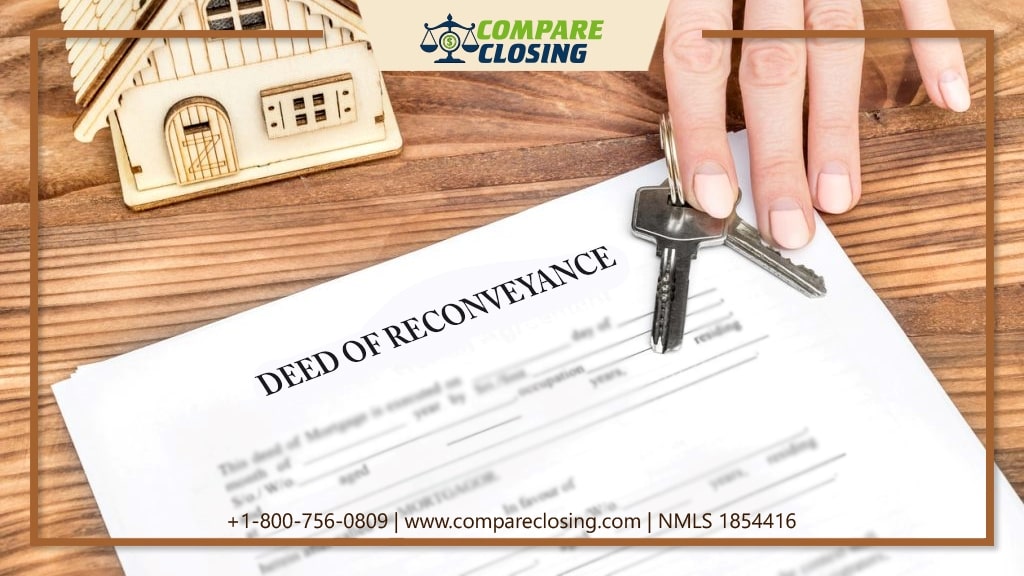Table of Contents
- What Are Netting Escrows & How Does It Work?: The Best Guide - January 2, 2024
- The Secret About Prescriptive Easement: Top Guide 1 Must Know - December 4, 2023
- About Home Equity Loans In Texas And How Can One Obtain It - November 27, 2023
About Deed Of Reconveyance
When you take out a mortgage to buy a house through a bank or a lender, the bank or the lender owns the property till the mortgage is paid in full. However, what happens if you pay off the mortgage?
Well, once you pay off the mortgage, you will receive a document from the lender known as a deed of reconveyance.
In this post, we will understand what is a reconveyance deed in detail.
What Is A Deed Of Reconveyance?
A reconveyance deed is a document that is provided to the borrower by the lender or the bank, once the borrower pays off the mortgage loan in full.
This deed indicates that the borrower has paid the mortgage in full and now owns the property.
The deed includes the legal property description along with the parcel number and other important details which is usually notarized.
How Does A Deed Of Reconveyance Work?
Once the borrower takes out a mortgage, he signs a deed of trust with the lender or the bank which states that the bank or the lender has a security interest in the property and puts the title of the property in trust with a trustee as a beneficiary.
This deed of trust is signed between the borrower and the lender so that in case the borrower defaults on the mortgage, the lender has the right to seize the property or foreclose and sell the property to recover the money.
The deed of trust holds until the reconveyance deed is brought into execution.
Once the borrower makes the last payment on the mortgage, the lender or the bank has to send this deed to the borrower within a specific time.
The deed will indicate the borrower repaid the mortgage in full, does not have any obligation to the lender and is the rightful owner of the property.
The bank or the lender releases all the rights over the property that was held as collateral at the time of providing the mortgage.
The deed needs to be signed by the trustee holding the deed of trust and has to be notarized.
In many states, the bank or the lender is by law required to share a copy of this deed within a specific time once the last payment is received from the borrower.
The lender will then submit a copy of the reconveyance deed to the county office to ensure the same is also updated in the public records.
This ensures that the homeowner now has a clear title and has no obligation to the lender or any other lien attached to the property.
It is the bank’s responsibility to prepare the reconveyance deed for the borrower. However, it is suggested that the homeowners make sure that the deed is executed in the right way and submitted to the county for an update in public records.
If the deed is not executed properly, the homeowner may face difficulty while selling the property in the future. In some states, the lenders might issue a document known as the satisfaction of mortgage instead of a deed of reconveyance.
Once the lender provides the deed, the lender cannot foreclose on that property. If the homeowner has a second mortgage or home equity loan, they need to be paid in full to be able to sell the property.
Failing to make payments on the second mortgage or home equity loan can lead to foreclosure of the property as the deed of reconveyance for the first mortgage would not be in effect for these loans.
When a homeowner refinances to lower the payments or to take cash out, they will receive a deed of reconveyance to show that the previous mortgage was paid in full.
Conclusion
A deed of reconveyance is one of the most important documents for a homeowner as it states that you own your property outright.
It is important for you to make sure that the conveyance deed is checked by the legal authority for errors and ensure that it is filled with your county office as part of public records.
If the deed is filed correctly will prove that you don’t have any outstanding liens on the property and you get a clear title.
Amanda Byford
Amanda Byford has bought and sold many houses in the past fifteen years and is actively managing an income property portfolio consisting of multi-family properties. During the buying and selling of these properties, she has gone through several different mortgage loan transactions. This experience and knowledge have helped her develop an avenue to guide consumers to their best available option by comparing lenders through the Compare Closing business.





